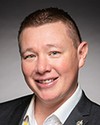Aaniin, everyone.
As a representative from the Indigenous Primary Health Care Council, which supports indigenous primary health care organizations across the province of Ontario, we would like to thank the House of Commons Standing Committee on Indigenous and Northern Affairs for the opportunity to appear as a panel witness in view of its study, administration and accessibility of indigenous peoples to the NIHB program.
In providing feedback to the study on the non-insured health benefits program, we are doing so through the lens of an end-user perspective that is first nations, Métis and Inuit inclusive and solicitous of the northern, rural and urban indigenous communities we service here in Ontario. The four themes and observations we would like to report on are contained under affordability, accessibility, exclusionary and safety.
With regard to affordability, significant challenges noted for the northern, rural and urban indigenous populations include the following.
Many service providers, whether they be dental, optometry, pharmaceutical or others, require indigenous clients to play for their services up front and then independently submit receipts to NIHB for reimbursement. For some, this creates affordability challenges, as the services can be quite expensive. When looking at eyewear expenses, costs can be hundreds of dollars. Costs for emergency dental care alone can be upwards of thousands of dollars. For example, root canal therapy alone averages between $520 to $1,200 per tooth.
Plus, there is a general lack of awareness among service providers regarding the NIHB program, especially in urban settings. Many service providers are unaware of the program and their ability to access or register. As such, in many cases, indigenous clients are not offered the option of provider-submitted reimbursement. Therefore, in many cases, indigenous clients are not offered the option of having the provider submit reimbursement on their behalf. If the client requests direct billing to NIHB, it is often denied by the service provider.
On the other hand, many service providers who are aware of the NIHB program choose not to participate because of the predetermination processes and the length of time to process. In addition, it is reported by providers that the wait times to receive payment back from NIHB is extensive, so some providers are opting not to register as a provider or to remove themselves as a provider on the pre-approved registry list.
Finally, out-of-pocket costs for travel remain a significant challenge for indigenous peoples in northern, rural and urban settings. For those living in northern and remote regions, their out-of-pocket costs for travel continue to escalate with increasing gas prices. For instance, the fees for driving are currently established at 22¢ per kilometre. This fee is not keeping up with the costs of inflation, and it further impedes the affordability of individuals to access appropriate health care.
Comparatively, reasonable allowance rates that were identified on the Government of Canada website for 2022 were as follows: 61¢ per kilometre for the first 5,000 kilometres driven, 55¢ per kilometre driven after that, and, in the Northwest Territories, Yukon and Nunavut, there was an additional 4¢ per kilometre. In addition, meals are reimbursed at a maximum of $60 a day, compared to the Government of Canada website of $69 per day without receipts.
For the urban indigenous population, all travel is out of pocket, as access to designated NIHB medical transportation is minimal due to the expansiveness of service provision. Individuals travelling to urban settings for services are required to pay up front for taxi and parking. Both costs are extensive, especially in metropolitan areas, where a lot of the specialty services are housed. Parking alone can range upwards of $30-plus a day in the downtown core.
All in all, upfront and out-of-pocket costs for travel and services create significant affordability issues for those who may not have the affordability to do so up front. As a result, this may force them to abandon their much-needed care completely. When they eventually enter the system, we are now seeing them in emergency settings rather than in curative or in preventative-type settings.
There are some additional things that we see with regard to challenges. There is limited access to service delivered by indigenous practitioners. While there is an NIHB service provider list for mental health, it is mostly comprised of non-indigenous practitioners delivering mainstream services.
Developing a similar list and funding indigenous practitioners with an emphasis on traditional healing and wellness supports is essential to healing, especially when we accept culture as treatment and culture as healing. Reclaiming with culture, land-based healing and connecting with cultural service providers are well-known strategies that successfully support the indigenous population on their healing journeys.
Travel also poses additional challenges from an accessibility lens. Often the approval process for medical transportation is delayed or not expedited in a timely manner, especially if specialty services are accessed at the last minute. This results in clients having to cancel their appointments. We know that the wait times for most specialists and diagnostic testing is quite extensive so this then imposes further delays to their treatment and care.
Connecting with NIHB representatives in real time when experiencing an issue or having questions is a significant challenge. This is a well-known reason why service providers choose not to work with NIHB. It is a contributing factor to many indigenous people not receiving the care that they need. In many cases, out of frustration, they will abandon the process and not obtain supports through the NIHB program because of it being time-consuming, complex and labour-intensive to navigate.



